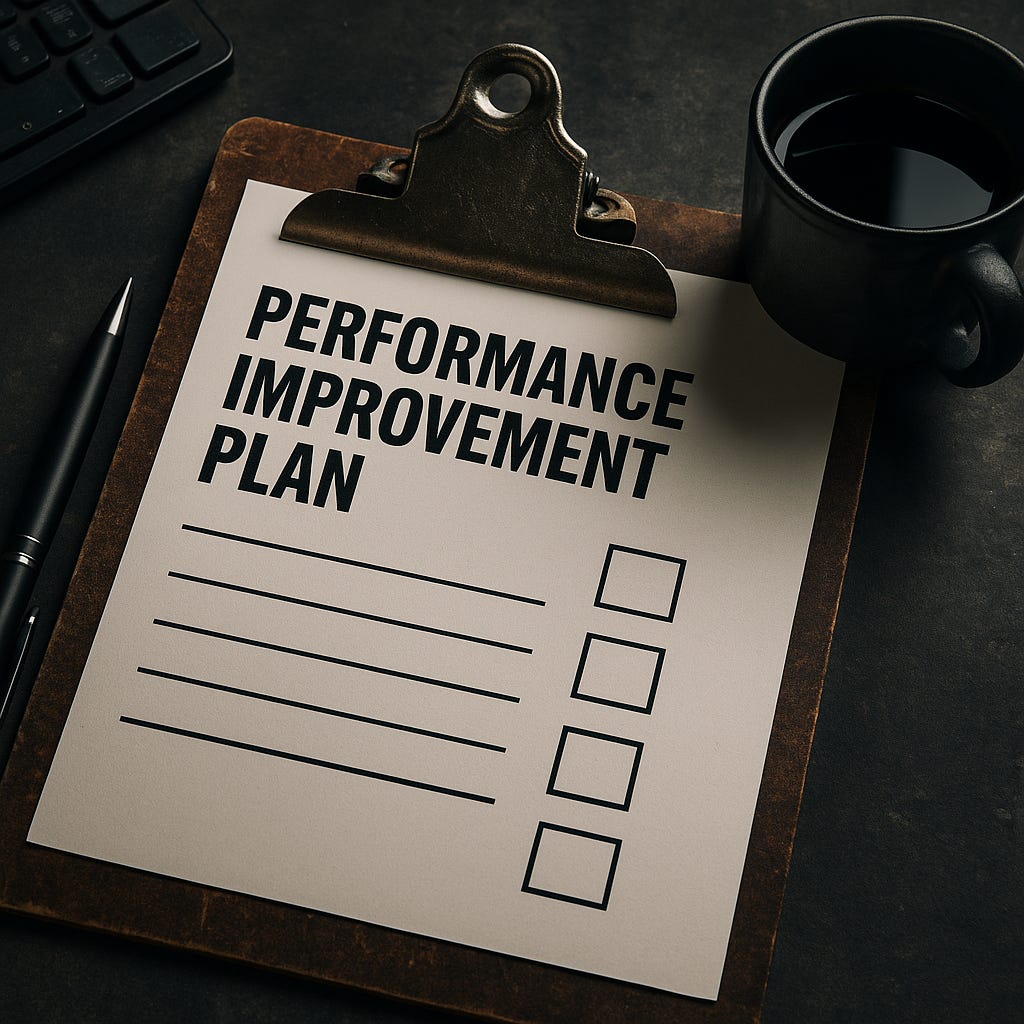Corporate Execution.....Inside the Modern PIP
Once a tool for development, the Performance Improvement Plan is now a velvet-gloved firing squad—designed to look helpful while doing exactly the opposite.
There was a time when Performance Improvement Plans—PIPs—were sold as lifelines. A well-intentioned structure for employee development. A documented opportunity to course-correct, learn, and climb back into the good graces of leadership.
That time, if it ever existed, is long gone.
Today’s PIP is less of a life preserver and more of a bureaucratic last meal. A tool for HR to paper over a firing. A shield for cowardly managers. A loophole that keeps companies “compliant” while showing employees the door.
PIPs haven’t evolved. They’ve mutated. And in most cases, by the time one lands in your inbox, you’re already on the chopping block.
The Numbers That Tell the Real Story
Let’s rip the Band-Aid off with some data:
6% of employees placed on a PIP remain with their company one year later.
A 2022 Harvard Business Review survey showed that 92% of managers admitted to using PIPs after deciding to fire someone.
In tech, the average time between PIP initiation and termination is 29 days.
58% of employees placed on a PIP said they received no prior formal warning.
Women, Black, Indigenous, and People of Color employees are 29% more likely to be placed on a PIP than their white male counterparts.
Meanwhile, zero CEOs were placed on PIPs last quarter. Because, of course.
The data doesn’t lie. PIPs are less about performance improvement and more about legal insulation and image control.
The Mechanics of a Trap
Here’s the standard PIP recipe:
Step 1: HR and your manager meet behind closed doors. You’re not invited.
Step 2: A document is drafted—three pages of generic jargon and “metrics.”
Step 3: You’re called into a “quick sync” with HR present. You realize this is not a sync.
Step 4: You’re handed the PIP with a 30- or 60-day window.
Step 5: Weekly “check-ins” begin. Every meeting is a performance trial.
Step 6: You’re told to “collaborate better” and “lead with more clarity.” There is no clarity on what those mean.
Step 7: The plan ends. The outcome was decided before Step 1.
Your coworkers know. Your boss avoids eye contact. You now spend every hour documenting your tasks, managing perceptions, and counting the days until you can either quit or be “formally exited.”
The Double Standard of Accountability
Let’s say the VP of Ops blows $4M on a failed initiative—do they get a PIP? Of course not. They get a “pivot.”
But if the frontline team lead struggles with onboarding during a hiring freeze? PIP.
There’s a class system here:
Executives fail and call it strategy.
Managers fail and call it reorg.
Employees fail and get a 30-day clock to fix what’s often not even their fault.
PIPs are rarely about the actual performance and almost always about how replaceable you are.
Spoiler: the higher you are in the food chain, the less likely you’ll ever taste one.
The Weaponization of “Improvement”
PIPs have been rebranded from “tools for support” into “tools for strategy.” Some creative use cases from real-world companies:
Budget Cuts? Easy—PIP underperformers and avoid severance.
Need a Scapegoat? PIP someone after a failed launch and shift blame.
Political Threat? Got a peer rising too fast? Nudge their boss toward a PIP “just in case.”
Legal Cover? Worried about wrongful termination? Drop a PIP in their file first.
The Performance Improvement Plan has become a legal device masquerading as mentorship. It’s HR’s way of saying “we tried” while never actually trying anything.
Inside the PIP Experience
If you've never been on one, congratulations. But here’s what it feels like for those who have:
Your every move is monitored.
Coworkers pull away. No one wants proximity to someone who's already being erased.
Weekly meetings become cross-examinations.
You start working nights—not to perform better, but to protect yourself with over-documentation.
You’re asked to hit goals with no new resources, no support, and often no clear direction.
And the kicker? If you do somehow meet those targets, you’re still viewed as damaged goods. Managers don’t “unsee” the PIP. Your name is no longer tied to your performance—it’s tied to that document.
The Real Purpose, and the Culture It Breeds
Let’s stop pretending.
The modern PIP isn’t about performance—it’s about process. And it says more about the company than it ever does about the employee.
Companies that rely heavily on PIPs are companies that:
Don’t give honest feedback early.
Avoid conflict until it's formalized.
Think process is a substitute for leadership.
View people as risk to be mitigated, not talent to be nurtured.
And worse, they create cultures of fear:
People don’t take risks.
Colleagues stop collaborating out of self-preservation.
“Accountability” becomes a code word for “someone’s getting fired.”
The irony? Leaders who praise “psychological safety” are often the same ones signing off on 30-day ticking time bombs for under-resourced, mismanaged, or politically inconvenient employees.
When you PIP someone without having invested in them, without having led them, without giving them air cover or clarity—you’re not improving them.
You’re just pretending to be ethical while pushing them off a cliff.
Final Word
A well-intentioned PIP is possible. But it’s rare.
If you must use a PIP:
Make it collaborative, not adversarial.
Don’t surprise people—feedback should be ongoing.
Align on outcomes and give support.
Have a real recovery path.
Be human.
If you can’t do those things? Don’t fake it. Just be honest.
Say what’s real. Tell the truth. Handle the exit with respect. Don’t bury your cowardice in 3 pages of corporate fucking bullshit


